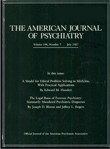Dr. Mulsant and Colleagues Reply
TO THE EDITOR: We thank Dr. Abrams for his interest in our report of a high rate of inadequate pharmacologic treatment in a group of patients with psychotic depression who were referred for ECT.
The focus of our study was the adequacy of the pharmacologic treatment received by our patients before referral to ECT, not the relative efficacy of ECT and pharmacotherapy with an antidepressant and an antipsychotic. We agree with Dr. Abrams that ECT constitutes a legitimate and efficacious first-line treatment for these severely ill patients. However, we apparently have a more favorable opinion of the value of an antidepressant-neuroleptic combination, which we consider to be an appropriate alternative, particularly for patients who are ambivalent about or who are not willing to consent to ECT (1). This evaluation is supported by the results of two well-designed, double-blind randomized clinical trials (2, 3), as well as by the recommendations of the American Psychiatric Association (4).
We hope that Dr. Abrams would agree with us that antidepressant treatment alone is not optimal in most cases of psychotic depression. The underutilization of combined treatment and the use of clearly subtherapeutic doses of neuroleptics were the key points that we were “bemoaning” in our article. Parenthetically, the patients with psychotic depression discussed in our 1997 article were not included in our 1996 study.
We also share Dr. Abrams's conviction of the necessity of randomized clinical trials that compare short- and long-term outcomes and health care costs of patients with psychotic depression who are treated with either ECT or an antidepressant-antipsychotic combination. However, this type of study will necessitate a very large cohort (i.e., 200–300 patients) and, thus, the participation of several research groups in a multicenter trial. We would welcome Dr. Abrams to join us in calling for the formation of such a collaborative research group.
1. Kroessler D: Relative efficacy rates for therapies of delusional depression. Convuls Ther 1985; 1:173–182Medline, Google Scholar
2. Anton RF Jr, Burch EA Jr: Amoxapine versus amitriptyline combined with perphenazine in the treatment of psychotic depression. Am J Psychiatry 1990; 147:1203–1208Google Scholar
3. Spiker DG, Weiss JC, Dealy RS, Griffin SJ, Hanin I, Neil JF, Perel JM, Rossi AJ, Soloff PH: The pharmacological treatment of delusional depression. Am J Psychiatry 1985; 142:430–436Link, Google Scholar
4. American Psychiatric Association: Practice Guideline for Major Depressive Disorder in Adults. Am J Psychiatry 1993; 150(Ap suppl)Google Scholar



